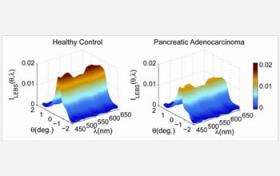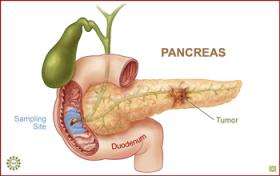Determining risk for pancreatic cancer

In the latest clinical trial for a technique to detect pancreatic cancer, researchers found they could differentiate cells that are cancerous from those that are benign, pre-cancerous, or even early stage indicators called mucinous cystic lesions.
Pancreatic cancer is dangerous to screen for, yet deadly if ignored. The pancreas is extremely sensitive--biopsies can lead to potentially fatal complications--but with few symptoms, the cancer is usually detected too late.
The disease is the fourth largest cause of cancer-related deaths in the United States, with a five-year survival rate of less than 5 percent. If doctors can find ways to identify early precursor lesions, the disease can be prevented in most individuals.

Reporting online Feb. 10, 2009, in the journal Disease Markers, researchers from Northwestern University and Evanston Northwestern Healthcare report convincing results with their minimally invasive methods for detecting pancreatic cancer.
"This technique allows us to detect changes in cells that look normal using microscopy," says co-author Vadim Backman of Northwestern University. "This level of detail allows us to detect cancer in its earliest stages."
Their techniques, called four-dimensional elastic light scattering fingerprinting (4D-ELF) and low-coherence enhanced backscattering spectroscopy (LEBS), identify the cancer and its precursors by analyzing light reflected off cells in the duodenum, a section of the small intestine adjacent to the pancreas.
"I'm excited about this work," said Leon Esterowitz, the National Science Foundation (NSF) biophotonics program director who helped fund this study and the development of the 4D-ELF and LEBS technologies. "I believe these results are very promising, and the techniques have a high probability of success for not just detecting early pancreatic cancer, but pre-cancer, so doctors can go ahead and treat the patient while there's still a chance to defeat the disease." Esterowitz added. "For pancreatic cancer, this could lead to not only an excellent prognosis, but perhaps even a cure."
While earlier success had shown that the techniques could tell cancerous from non-cancerous tissue without resorting to a biopsy, the new study of 203 individuals was the first to show the method can identify various disease stages and risk factors, including a possible signature related to "family history."
The researchers' approach had a sensitivity of 95 percent for determining healthy tissue from cancerous tissue and appears to be the most successful yet developed for detecting pancreatic diseases at curable stages and for identifying high-risk individuals.
"These optical techniques have shown promise for detecting both colon and pancreatic cancer," says Backman. "Our hope is to continue to test the ability to detect other forms of cancer, which would greatly expand the impact of the technology." In ongoing work, the researchers will continue to refine their instrumentation and hope to validate the recent findings with further clinical trials.
Source: National Science Foundation





















